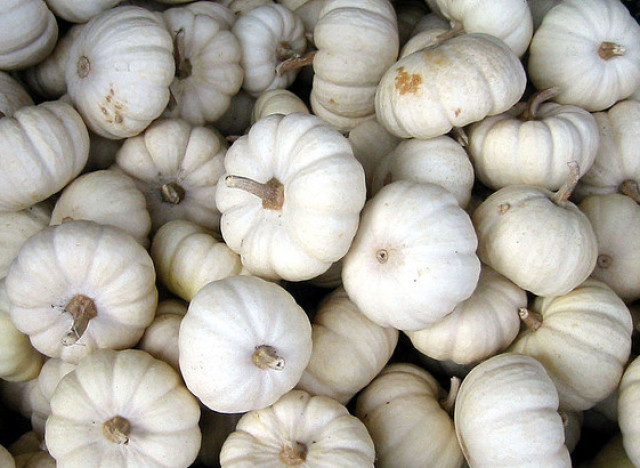
Flickr photo by dystopos
No other fruit out there can inspire such imagination as a pumpkin does. For the last couple weeks I have been watching people's faces light up, no matter what age, as they peruse around the various shapes and colors of these muses of fairy tale and folklore. A pumpkin is technically a type of squash of the genus Curcurbita and native to North America. Did you know that in some countries it was (and still is) tradition to carve turnips to celebrate harvest time and it was North America that upsized the carving vessel to a pumpkin? The traditional American pumpkin is the Connecticut Field variety but there are so many options out there, why just stick with the traditional one? And while you're at it, just throw out the notion that a pumpkin is orange.
If you are more in to painting your pumpkin then carving it a white pumpkin such as Lumina, Snowball, Cotton Candy or miniature Baby Boo, is the perfect canvas. Elegant as decoration the white pumpkin can also be substituted for orange pumpkin in most cooking recipes.

Flickr photo by bryanto
Why not try a blue pumpkin such as Australian blue or Jarrahdale? The flesh of the blue pumpkin is orange as any other pumpkin but in contrast with the ghostly blue/grey skin it can be quite mesmerizing and eerie. Not willing to go quite as far as the white or blue pumpkins? There are also red varieties out there including Red Lakota, Red Warty and Cinderella. A pumpkin called appropriately the Rouge Vif d'Estampes is supposedly the red pumpkin that Cinderella's carriage was actually fashioned after.
Besides decorating, pumpkins are also great for eating and can be boiled, baked, steamed or roasted when ripe. The seeds are a good source of protein, zinc and other vitamins. If eating them is not your forte then try mixing in some fun shaped gourds to your fall entourage such as birdhouse and bule. Gourds are also part of the squash family and can last indefinitely if cared for meaning letting them dry and stored properly when not in use.
With so many heirloom and decorator varieties available why not try planting a pumpkin from seed and watch it grow? Pumpkins are a warm weather crop that are usually planted in early July. Soil temperatures need to be at least 60 degrees three inches deep and the soil needs to be rich in nutrients and hold water well. Frost can be detrimental so make sure you plan enough time for you plant to mature and be picked before the cold hits. Welcome harvest time.